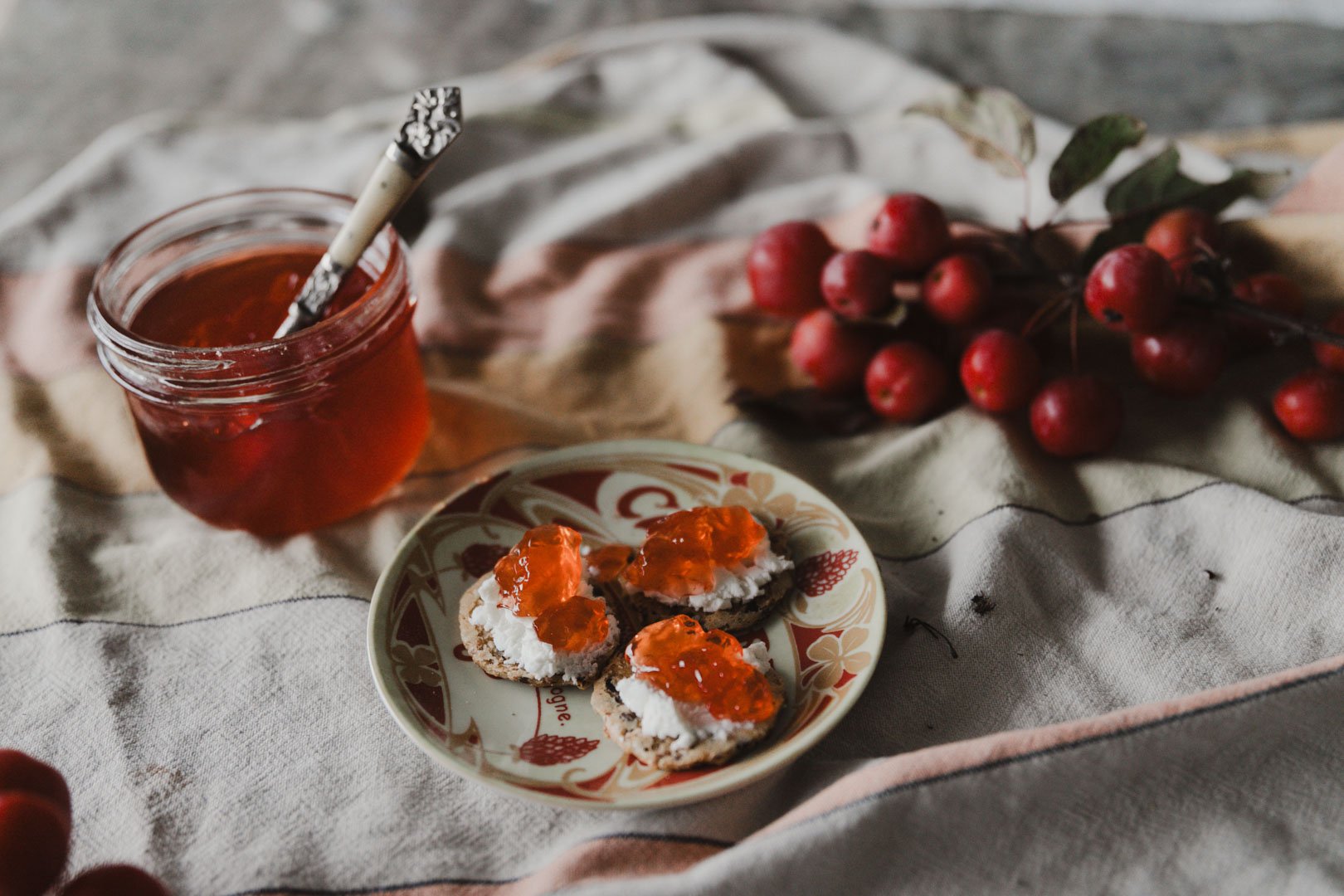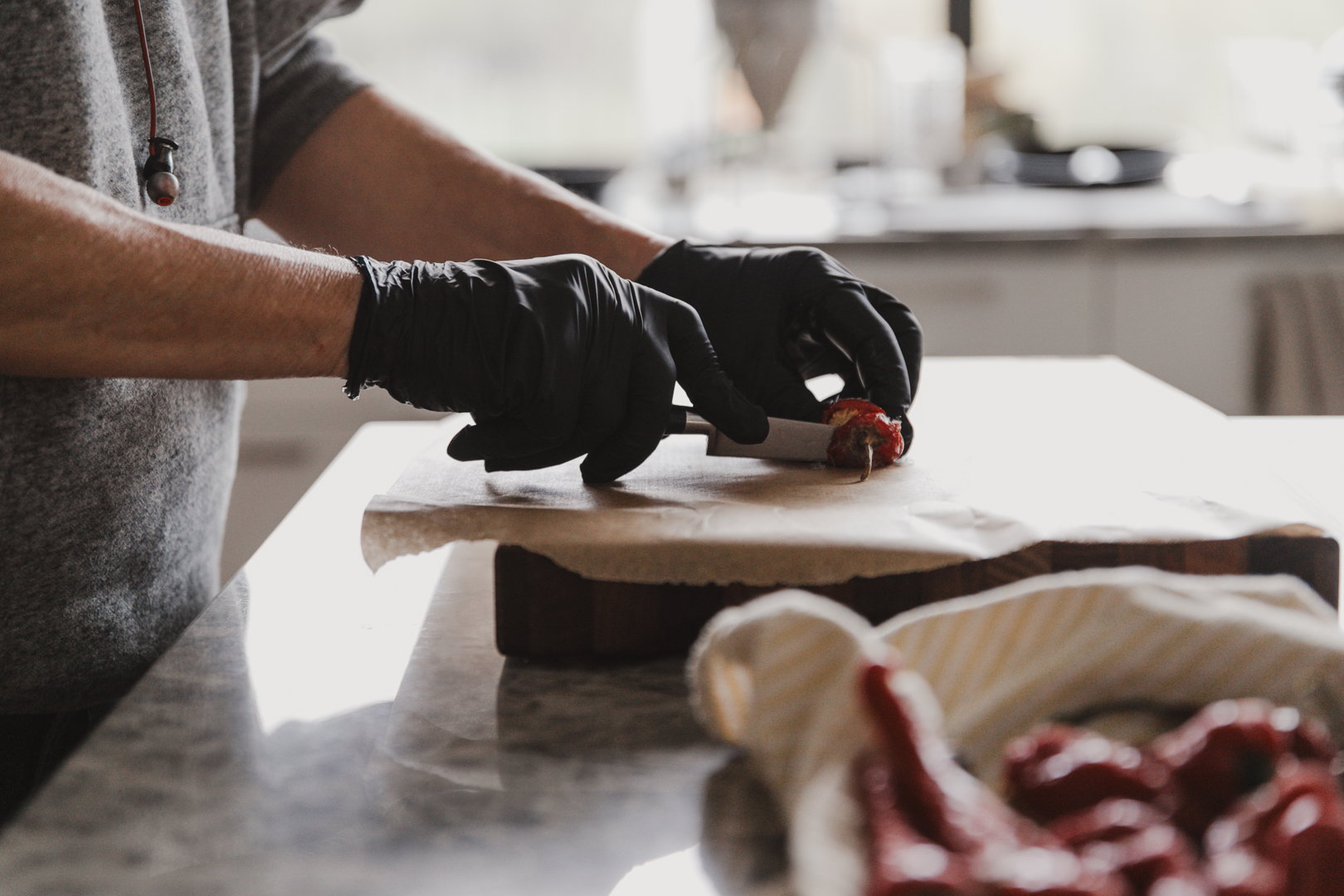How To Make Spicy Crab Apple Jelly; Farm to Table
As the holiday season approaches, the desire to give meaningful and heartfelt gifts becomes increasingly prominent. One of the most delightful ways to spread joy and show appreciation is by creating your own Christmas gifts. This year, let's embark on a journey of crafting and sharing with a special touch — homemade Crab Apple Jelly.
This specific recipe includes a bit of heat with my hand-grown peppers which makes this jelly perfect for savoury treats!
The Benefits of Handmade Christmas Gifts
1. Personalized Touch
Homemade gifts carry a unique, personal touch that store-bought items often lack. Crafting something with your hands expresses care and consideration, making the recipient feel truly special.
2. Sustainable Living
Making your own gifts aligns with the principles of sustainable living. By utilizing homegrown ingredients, you contribute to a more sustainable and eco-friendly lifestyle. In this case, we're using crab apples grown in our very own garden.
3. Cost-Effective
Creating homemade gifts is often more cost-effective than purchasing store-bought alternatives. With a few simple ingredients and a bit of time, you can produce a meaningful and budget-friendly present.
4. Share the Joy of Cooking
Homemade gifts offer a wonderful opportunity to share the joy of cooking and preserving traditions. It's a chance to pass down family recipes and create lasting memories in the kitchen.
Growing and Harvesting Your Own Crab Apples
Crab apples are highly underappreciated, often written off due to their sour taste when freshly picked. Edible crabapples are basically mini apples that vary in size from about 3/4 to two inches – any smaller than this, and they are considered “ornamental,” and will be too bitter to be edible.
I grow Sentinel crab apples here at Sage and Solace, in Zone 8 around Vancouver, BC and this year I had fully ripe and delicious crab apples well into November.
When harvesting you want to be patient and wait for the apples to be completely ripe, to check for ripeness pick a fruit and cut it open. If the seeds inside are brown then you’re good to go! If not they’re not ready.
Many trees have “persistent” fruit, meaning that even when they’re ripe they’ll remain hanging on the tree for a month or more.
Crafting Pepper Crab Apple Jelly: A Recipe from Our Garden to Yours
In this particular recipe, I added in some of my own peppers to add an extra kick and make the jelly perfect for savory treats like bagels, crakers, and toast!
Ingredients:
4 cups of fresh crab apples, washed and chopped (including peels and cores)
Fresh Peppers
4 cups of granulated sugar
Applecider Vinegar
Water
Instructions:
Prepare the Crab Apples: Wash the crab apples thoroughly and remove the stems. I also like to pull off the small black stems on the bottom of the apples. I’ll also cut off any pieces that are rotten, this helps keep the jelly crystal clear in the end.
Washing the Apples
Cutting and Removing “bad” parts
Cooking the Crab Apples: Place the crab apples in a large pot, add enough water to cover the apples and simmer over medium heat until the apples are soft and mushy, this is also when I added in some peppers from my garden.
Add water to a pot
Slow boil to soften the apples
Extract the Juice: Once the apples are soft, strain the mixture to extract the juice. You can use a fine mesh sieve or cheesecloth to separate the liquid from the pulp.
Strain the liquid using a cheesecloth
I slightly mashed the apples before straining them using a potato smasher
Cooking the Jelly: In a new pot, combine the crab apple juice, sugar and apple cider vinegar. Bring the mixture to a boil, stirring frequently. Continue boiling until the jelly reaches the desired consistency.
There is a trick here, that involves a slight amount of science.
The National Center for Home Food Preservation outlines it here:
Temperature Test – Take the temperature of the jelly with a candy or jelly thermometer. When done, the temperature of the jelly should be 220°F, 8°F above the boiling point of water, if you are at sea level. NOTE: For each 1000 feet of altitude above sea level, subtract 2 degrees F. For instance, at 1,000 feet of altitude, the jelly is done at 218°F; at 2,000 feet, 216°F, etc.
Add sugar to the strained mixture
Gently heat until 220F, avoid burning by constantly stiring
Sterilize Jars and Fill: Sterilize glass jars and lids by boiling them or using the dishwasher. Fill the jars with the hot crab apple jelly, leaving a small space at the top.
Fill the jars
Clean of the edges of the jars to ensure a proper seal
Seal and Cool: Seal the jars and allow them to cool completely before storing them in the refrigerator or a cool, dark pantry.
Gifting with Love
Presenting a jar of homemade crab apple jelly goes beyond just giving a tasty treat. It's a symbol of time, effort, and a personal touch from your home to theirs. Attach a handwritten note with the recipe or a heartfelt message, and your gift becomes a cherished holiday memory.
This Christmas, embrace the joy of homemade gifts and share the goodness of your garden with those you love. Crafted with care and infused with the flavors of homegrown crab apples and peppers, your homemade pepper crab apple jelly is sure to bring smiles and warmth to the holiday season.
Troubleshooting:
Making crab apple jelly is a delightful process, but like any kitchen adventure, unexpected challenges may arise. Don't worry; we've got you covered with some troubleshooting tips to overcome common issues and ensure your jelly turns out perfectly.
2. Cloudy Jelly:
Possible Causes:
Using overripe crab apples.
Material not strained.
Overcooked
Solution:
Strain the juice more carefully during the extraction process.
Avoid excessive stirring during the boiling phase.
1.Jelly Won’t Set
Possible Causes:
Insufficient cooking time.
Not enough natural pectin in the crab apples.
Solution:
Reboil the jelly, ensuring it reaches the gel point. Test its consistency regularly by placing a small amount on a cold plate.
4. Jelly Too Sweet or Tart:
Possible Causes:
Varying sweetness levels in crab apples.
Incorrect sugar measurement.
Solution:
Taste the crab apples before cooking and adjust sugar accordingly.
For tartness, consider adding a bit more lemon juice.
3. Excessive Foam:
Possible Causes:
Boiling too vigorously.
Not skimming off foam during cooking.
Solution:
Reduce heat during boiling to a gentle simmer.
Skim off foam regularly to achieve a clearer jelly.
6. Mold or Spoilage:
Possible Causes:
Inadequate sterilization.
Incorrect storage conditions.
Solution:
Always sterilize jars and lids before filling.
Store jelly in a cool, dark place and refrigerate once opened.
5. Jars Not Sealing:
Possible Causes:
Jars or lids not properly sterilized.
Not filling jars to the correct headspace.
Rims not cleaned.
Solution:
Ensure jars and lids are thoroughly sterilized.
Leave the recommended amount of headspace to allow proper sealing.
Wipe off excess jelly from the rims of the jars
7. Unpleasant Odor:
Possible Causes:
Overcooking or burning during the boiling phase.
Solution:
Pay close attention during boiling and maintain a moderate heat.
By troubleshooting these common issues, you'll be better equipped to navigate the nuances of crafting perfect crab apple jelly. Don't be discouraged by challenges; they're part of the learning process. With a bit of practice, you'll master the art of jelly making and continue to enjoy delightful homemade treats.
Frequently Asked Questions About Making Crab Apple Jelly
Q: Can I use other types of apples for this recipe?
A: While crab apples are ideal due to their high natural pectin content, you can experiment with other tart apple varieties. However, be prepared to adjust sugar levels and possibly use additional pectin if needed.
Q: Why is my jelly not as vibrant in color as store-bought versions?
A: Store-bought versions often contain artificial colors. The natural color of homemade crab apple jelly can vary depending on the apple variety and ripeness. Enjoy the authentic, natural hues of your homemade creation.
Q: Is it necessary to sterilize jars, and how do I do it?
A: Yes, sterilizing jars is crucial for preventing mold and spoilage. Wash jars and lids in hot, soapy water, rinse thoroughly, and sterilize by placing them in boiling water for 10 minutes or using a dishwasher's sterilized setting.
Q: Can I reduce the sugar in the recipe for a healthier option?
A: The sugar in jelly serves not only as a sweetener but also as a preservative. Altering the sugar content may affect the jelly's set and shelf life. For a healthier alternative, consider using reduced-sugar pectin.
Q: My jelly is too runny. What went wrong?
A: Insufficient cooking time or not reaching the gel point could result in a runny consistency. Reboil the jelly and test regularly on a cold plate until it reaches the desired set.
Q: How long can I store crab apple jelly, and what's the best way to store it?
A: When properly sealed and stored in a cool, dark place, crab apple jelly can last up to a year. Once opened, refrigerate for optimal freshness.
Q: Can I freeze crab apple jelly?
A: Yes, crab apple jelly can be frozen for longer storage. Ensure the jars have sufficient headspace to accommodate expansion during freezing.
Q: Can I use honey or other sweeteners instead of sugar?
A: While you can experiment with alternative sweeteners, it may impact the jelly's texture and shelf life. Ensure to follow recipes designed for specific sweeteners for the best results.
Q: Can I add spices like cinnamon or cloves for flavor?
A: Absolutely! Experimenting with spices adds a delightful twist to your jelly. Add them during the cooking process and adjust quantities based on your taste preferences.
























